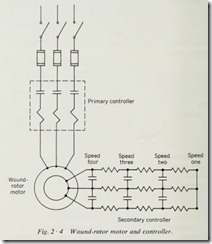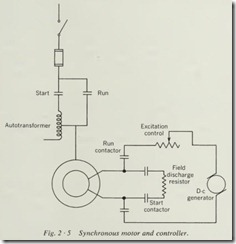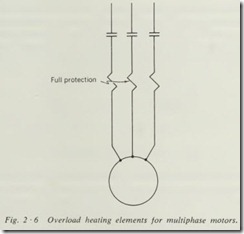2 · 5 STARTING SYNCHRONOUS MOTORS
The synchronous motor starts as a squirrel-cage motor with a resistor connected across the field winding to dissipate the power generated in this winding (Fig. 2 ·5) Usually the stator con troller is a reduced-voltage starter with the addition of a slip frequency or field-application relay to apply d-e voltage to the rotor at about 95 percent of synchronous speed. The slip-frequency relay must also remove field excitation and connect the field resistor if the motor should pull out of step. If the excitation is not removed, the stator winding will be subject to damaging current. The synchronous motor should be provided with an incomplete-sequence relay to protect the starting winding if the starting sequence should not be completed. Provision must be also made to adjust the field excitation.
While the above description of the starting of a synchronous motor may seem to be oversimplified, it is intended to be gen eral in nature and to apply to all synchronous motors. For a specific application of a definite type of synchronous motor, the manufacturer ‘s literature on the individual motor should be consulted. Many synchronous motors are designed for specific applications and vary somewhat from this general outline for starting in that they require additional steps or equipment.
2·6 SELECTION OF STARTING CONTROLLERS
There are several points that must be considered when selecting starting controllers. Listed below are some questions that should be asked whenever selection of a controller is necessary:
1. Is it designed for the type of motor to be used?
2. Does the motor require reduced-voltage starting?
3. Is speed control needed?
4. Does the controller offer all the types of protection that will be needed?
5. Are the line and control voltages and frequency correct?
Analyze the needs of the machine and the motor before select ing any controller, and avoid costly mistakes.
2 ·7 OVERLOAD PROTECTION
Overload of a motor may be mechanical or electrical in origin; therefore, the overload protection must be sensitive to either. The current that a motor draws from the line is directly propor tional to the load on the motor, so if this current is used to activate the overload protection device, the machine as well as the motor will be protected.
Overload protection is achieved in almost all controllers by placing heating elements in series with the motor leads on multi phase motors ( Fig. 2 ·6). These heater elements activate electri cal contacts, which open the coil circuit when used on magnetic controllers. When used on manual starters or controllers, the heating elements release a mechanical trip to drop out the line contacts. Older controllers use two overloads, while newer units are required to have three units.
The overload relay is sensitive to the percentage of overload ; therefore a small overload will take some time to trip the relay. whereas a heavy overload will cause an almost instantaneou s opening of the circuit. The overload relay does not give short-cir cuit protection, however. It is quite possible that under short-cir cuit conditions the relay might hold long enough to allow consid erable damage to the motor and other equipment.
It would be impossible to overstress the necessity of proper selection of overload protective equipment. The manuf acturer’s rating of running current for a specific motor should be adhered to in the selection of the heating elements for overload relays. The all too frequent practice of increasing the size or rating of the heater element beyond the value called for is probably the greatest single cause of motor failure in industrial plants today. When a motor is tripping its overload units, a careful check of the actual current drawn should be made in order to de termine whether the fault lies in the overload protective device or in the motor itself actually drawing excessive current. Should the motor be found to be drawing excessive current, then it must be determined whether this is caused by mechanical over load or by defective windings within the motor itself. Many times, today’s heavy production schedules require that the operator demand more from his machine than its motor is capable of producing. The practice of increasing the allowable current through the overload units will only hasten the time when a shutdown of the equipment is necessary in order to rewind or replace the motor.
When one phase of a motor circuit fails, the motor is subject to what is commonly called single phasing. This condition causes an excessive current to flow in the remammg motor windings and leads. In most cases, this excessive current will cause the overload units to trip, thus disconnecting the motor from the line and preventing a burnout of its windings . Under certain particular conditions of load characteristic of the individual motor, it is possible for the motor to run single phase and burn out its windings , even though there are two overload units in the control device. Modern devices are required to have three overload units.
2 · 8 SHORT-CIRCUIT PROTECTION
Squirrel-cage motors draw up to 600 percent of full-load current when starting, and some designs draw up to 800 percent or more. The overload relay is designed to pass these large currents for a short period of time. The circuit feeding a motor must have either a fused disconnect or a circuit breaker ahead of the motor to give short-circuit protection since the motor controller is not designed to interrupt short-circuit currents greater than 10 times its rating. Class J fuses (or current limiters of the same character istics) provide the best limiting of peak short-circuit current.
The dual-element fuse (Fig. 2 ·7) is so constructed that one of its elements consists of a fuse link. This link will open very rapidly under short-circuit conditions . The second element in this type of fuse consists of a thermal element which has consid erable time lag in the process of breaking the circu it. The net result of using the dual-element fuse on motor circuits is to give short-circuit protection through the fuse link and yet a de gree of overload protection in the thermal element. This type of fuse is used extensively with small fractional-horsepower motors which have built-in thermal protectors.
The use of thermal-magnetic circuit breakers for short-circuit protection offers a degree of time lag for starting loads in that such breakers have a thermal device which requires some time lag to open on currents less than 20 times rating. This time lag is inversely proportional to the amount of current. The larger the overload, the shorter the time required to open the circuit. Such breakers also have a magnetic trip element for instantaneous trip on currents greater than about 25 times rating.
2 ·9 LIMIT PROTECTION
Limit protection, as its name implies, must limit some function of the machine or its driving motor. The most common type of limit control is used to limit the travel of a cutting tool or table or other part of a machine tool. When the cutter reaches a predetermined setting, it will activate a limit switch, causing the motor to reverse and the machine to return to the other ex treme of travel. There are other types of limit protection, such as limits for over- or underspeed of the driven machine. There are also limit controls which do not reactivate the machinery at all but merely stop the motor until corrections have been made by the operator.
This type of protection is accomplished by the use of limit switches, which will be discussed fully later. Basically, a limit switch is merely a switch with a mechanical bumper or arm that will allow some action of the machine to throw the switch mechanism. Limit switches are one of the most frequently used control devices on machines today .



